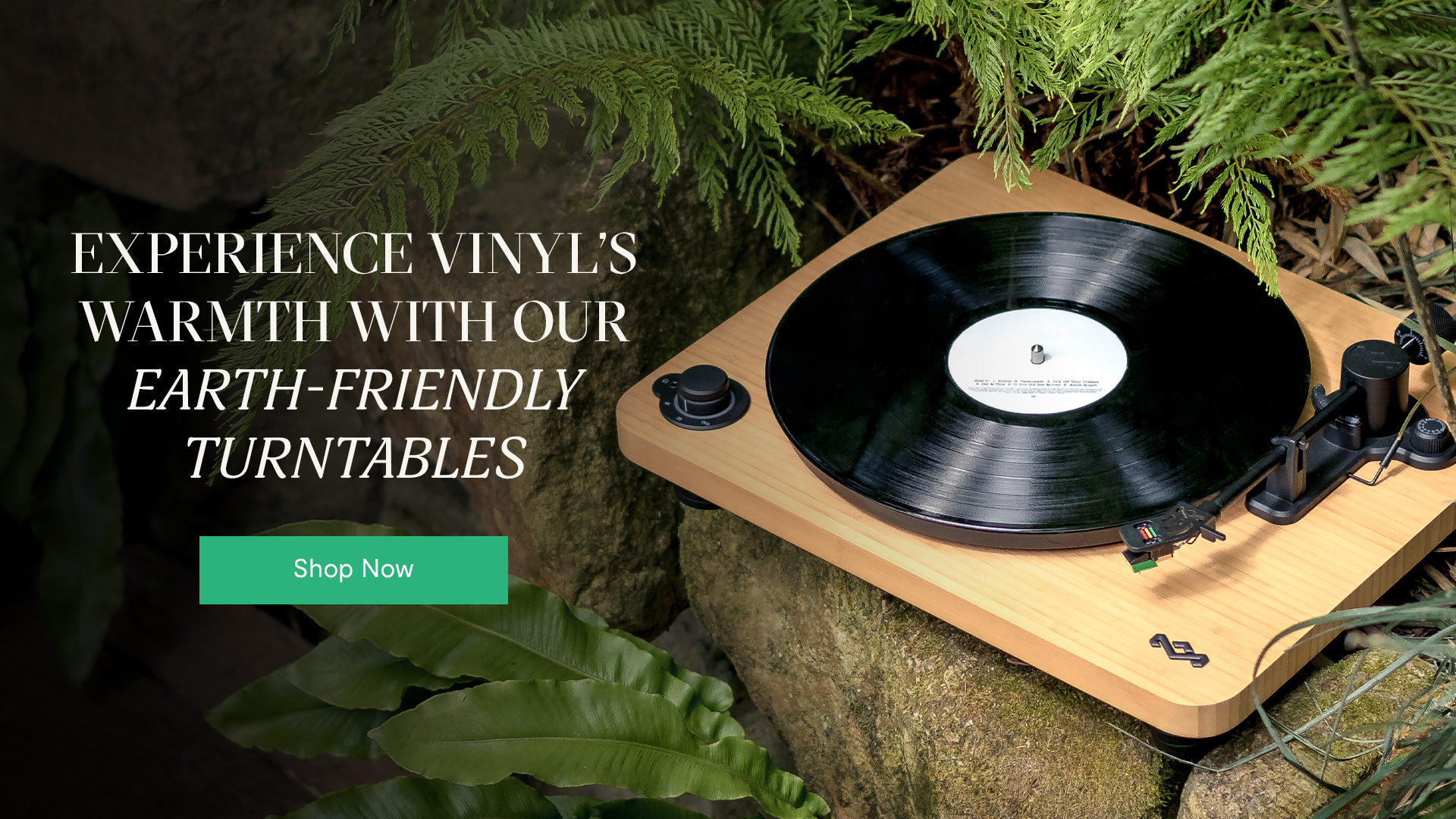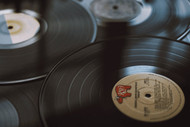Definition Of Vinyl And More: What These Words Really Mean
Posted by House of Marley on Mar 11th 2022
Vinyl records are the classic way to listen to music and get closer to the artists you’re passionate about, but it helps to learn the lingo before you drop the needle—and there’s a lot to learn. With more knowledge, you’ll be able to make better decisions about what to buy, whether you’re shopping turntables or your local record shop. No matter which stage you’re at in your vinyl journey, we can help you gain a better understanding of vinyl record terminology.
Keep reading to learn the common words and terms you’ll come across while shopping at your local record store or getting familiar with a new record player.

What Are Vinyl Records?
Before streaming, MP3s, CDs and cassette tapes, spinning a vinyl record was the preferred way to enjoy music. This classic listening experience has been around for decades, and people are falling in love with vinyl all over again. Even in a world where streaming platforms are dominating, the charm and nostalgia of vinyl are irreplaceable.
You’ve seen vinyl records before, but how do they work? Vinyl records have small micro-grooves that contain an imprint of recorded sound. As a vinyl record spins, the record player’s needle passes through the groove to reproduce the sound written on the surface of the disc.
Vinyl Record Terms You Should Know
It’s important to learn some vinyl record terminology before you browse the bins at your local record store. While you don’t have to know the language to enjoy listening to vinyl records, understanding the ways people describe turntables and LPs can help you while you shop. Besides, there’s no better feeling than striking up a conversation with the record store clerk about your favorite record pressings!
Cover
The cover of the record, also called the jacket, displays the album artwork and holds the vinyl record and additional inserts, booklets or posters. Depending on the record, you might find the album’s production credits in the liner notes on the back cover.
Depending on the pressing or the album, sometimes the same record could have different cover art—some quite rare. For example, The Beatles originally released their LP of non-album singles Yesterday and Today with the infamous “butcher cover” featuring decapitated dolls and raw meat. The album was quickly pulled and re-released with different cover art, making the original artwork highly collectible.
Gatefold
Gatefold refers to a type or record cover that opens and closes like a book. Record collectors love gatefold covers because they have additional images or album details on the inside. Many gatefold covers contain two vinyl records—one in the front cover and another in the back—this is called a double album.
Groove
Record grooves are imprints of recorded sound that the needle travels through to reproduce music. A groove—which would be roughly 500 meters long if stretched out linearly—starts at the exterior of the record and spirals towards the center.
Stereo record grooves are cut vertically and laterally, allowing each side of the groove to contain separate right and left channels. Mono record grooves are cut laterally, so they can only hold a single channel of information. Almost all modern records are mixed in stereo, but you might find some mono recordings when shopping for vintage records.
Sleeve
When it comes to vinyl records, dust and debris can really kill the vibe. Record sleeves protect your vinyl. Paper inner sleeves are the most common, but other materials like rice paper and polypropylene are a nice upgrade to keep the dust away. Another bonus for poly sleeves is that they’re better at preventing mold—a killer of vinyl records.
Insert
Depending on the album, you might find some extra items in the record jacket. Record inserts are usually booklets or sheets of paper that display tracklists, artwork, lyrics, or album credits. For example, you might get lucky and find a poster tucked in Pink Floyd’s iconic LP, The Dark Side of the Moon.
RPM
RPM, or rotations per minute, is a measure of how fast a record needs to spin to accurately play music. Turntables feature up to three standard playback speeds—33 ⅓, 45 and 78.
33 ⅓ is the most common for 12-inch LPs (long-playing) records, 45 is most common for 7-inch singles and 78 was used for 10-inch shellac records—a now archaic format that was common pre-WWII. However, you might still find some 12” records that play at 45 RPM. The label will tell you if you need to play it at a different speed, but you’ll know as soon as you drop the needle.
Record Sizes
The 12-inch LP is the most common vinyl record size. These records hold up to 22 minutes of music per side and spin at 33 ⅓ RPM. Rarely, 12-inch records will contain singles and will play at 45 RPM, so if your Dolly Parton record sounds like Hozier instead, that’s probably why.
10-inch records were used for 78 RPM singles and the first long-playing records of the 1950s. Before vinyl was used to make records, 10-inch records were made from a brittle resin material called shellac. However, some artists release 10-inch EPs on modern vinyl occasionally. These 10-inch EPs are most often played at 33 ⅓ RPM, but check your record sleeve for the correct speed.
Like 12-inch LPs, 7-inch singles are equally common, but instead of holding a full album, these smaller records contain singles. 7-inch records play music at 45 RPM and require a circular adapter to fit the spindle of the record player.
180 gram / 200 gram
The weight of vinyl records is specified in grams. You may have noticed big “180 gram” or “200 gram” stickers on the corner of sealed vinyl records. The average LP is roughly 140 grams, but some audiophiles prefer heavier vinyl for its durability, thickness and deep sound.
Mono vs Stereo
While you’re digging the crates, you’ll mainly find stereo or mono recordings. Stereo records are the norm these days, as most people listen through two speakers to hear two channels of sound—left and right. Although they’re a little less common, you’ll also find mono recordings that only have a single channel of audio.
Despite attempts to standardize quadraphonic and duophonic records, they didn’t stand the test of time. Quadraphonic records are one of the earliest forms of surround sound. To listen to a quadraphonic record, you need four speakers to reproduce all four channels. Duophonic, also known as mock stereo, replicates stereo sound by splitting a mono signal into two identical channels, one with a little bit of reverb applied to give a slight stereo feel.
Records with Promo Stickers or Cut Corners
Sometimes you’ll find record covers with special distinctions like promo stickers, cut corners and punched holes that differentiate it from a standard retail copy.
Promo copies are records for non-retail uses only. In the past, disc jockeys were given special pressings that were only meant for promotional use during radio shows. Record companies used this tactic as a marketing strategy to dissuade DJs from reselling those promotional copies, which didn’t always work.
Record covers with punched holes signify that the record had been sent back to the record label or distributor, typically because it didn’t sell during its initial run at the record store. These records were then sold to wholesalers at a discount as a non-returnable item—by that we mean the store couldn’t return them to the label, and the customer likely couldn’t return it to the store, either.
Pressing
A pressing simply refers to a particular version of a vinyl record. Like books, popular vinyl records have dozens of alternate pressings that were produced apart from the initial release to keep up with demand.
There are multiple varieties of record pressings that range in value, depending on when and where it was pressed. First pressings are almost always considered more valuable, but subsequent pressings—especially remastered editions on heavier vinyl—may sound better.
Reissue
In the vinyl community, a reissue is a record with source material or packaging that varies from the original pressing. For example, you might find a reissue of a classic Bob Marley record that was pressed in 2020 using different master recordings than the original album. Reissues of classic 20th-century albums are the most common and often contain bonus recordings, extended liner notes and more.
Label
The label is the circular sticker that appears on both sides of the record. The physical record labels (not to be confused with the label, or the organization that released the record) feature basic information about the album, including tracklist, songwriters and other details about the manufacturer.
Some record labels only display minimal information or artwork instead. Some labels might even contain Easter Eggs for fans who look closely!
Get to Know Your Record Player
Record players have a lot of different components, but we can help you understand how they work. To get familiar with record players, check out this overview of record player terminology.
Stylus
The stylus, or needle, reads the music pressed into the vinyl record. As the stylus traces the groove, vibrations are sent to the cartridge and converted into electrical signals. Turntables come with a variety of stylus shapes and materials that affect sound quality and accuracy.
Cartridge
The cartridge is mounted at the end of your record player’s tonearm and holds the stylus in place. Cartridges are transducers that convert the stylus vibrations into sound. Within the cartridge, small magnets move up and down, producing electrical signals that travel to your sound system.
Tonearm
Record player tonearms have two different purposes. The front of the tonearm holds the cartridge at the proper position as the record spins. On the back of the tonearm, the counterweight adjusts the weight of the stylus tracking force.
Tonearms can make a big impact on sound quality depending on their shape and material. Straight tonearms are preferred for casual listening, whereas S-shaped tonearms are intended for DJ performances.
Tracking Force
All manufacturers specify a recommended stylus tracking force for the best sound and stylus longevity. If you notice the stylus skipping while listening to records, you should consider adding tracking force. Just be sure to avoid excessive force to prevent premature stylus wear or groove damage.
Anti-Skate
Anti-skate is a special setting you can adjust at the back of the tonearm, right near the counterweight. As the stylus follows the groove, it has the tendency to skip towards the center of the record. Anti-skate keeps the stylus in the center of the groove by gently pulling the stylus outward. Increasing the anti-skate setting causes the tonearm to apply additional outward force.
Is your record skipping? Try setting the anti-skate dial to match the weight of your stylus tracking force. When in doubt, check the manufacturer’s recommended settings.
Counterweight
As mentioned earlier, the counterweight is attached to the back of the record player’s tonearm. You can adjust the tracking force by rotating the counterweight forward or backward. Every record player is different, so make sure to check what the manufacturer recommends before you set it up. Applying too much force can permanently ruin your records or the stylus.
Platter
The platter is the circular spinning surface that the record rests on. Record players have small internal motors that rotate the platter at a steady RPM.
Spindle
The spindle is the small component that protrudes from the center of the platter. While the record spins, it keeps the vinyl record securely in place. Unlike 12-inch records, 7-inch singles require a small adapter to fit securely over the spindle.
Slipmat
Slipmats cover the surface of the platter and give the record a soft surface to rest against. They were originally used by radio DJs who needed to spin the record in either direction. However, most slipmats are purely meant to protect the record from the harsh metal surface of the platter.
Preamp
Preamps amplify the turntable signal to a level that’s loud enough for a sound system. While some record players, like our Stir it Up Turntables, have internal preamps, traditional models require an external phono preamp or a receiver with a phono input.
Wow and Flutter
Wow and flutter are audible changes in pitch caused by a deformity in the record or a mechanical problem from the turntable. Gradual changes in pitch are the “wow,” and rapid changes in pitch are “flutter.”
Vinyl isn’t perfect, but that’s why the music community adores it. Wow and flutter are audible qualities that make vinyl records unlike anything else. Despite the limitations of vinyl and all the convenient alternatives we have today, purists can’t keep their hands out of the record bins. Fair warning—your hands will get a little dusty.
Enjoy the Groove
With a better understanding of these basic terms, you can continue your vinyl record journey with the basic knowledge you need to shop with confidence. And when you’re ready to spin a record in style, check out House of Marley Stir It Up Turntables for the best listening experience.













